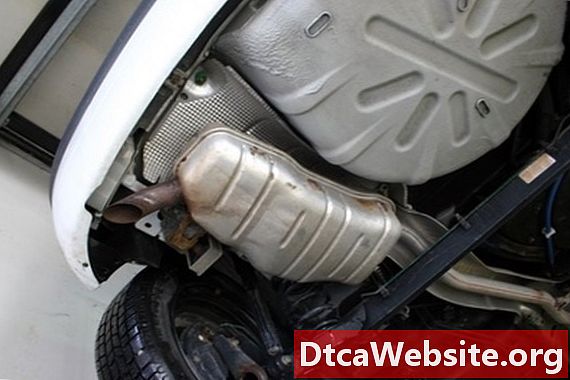
Contenu
- Muffler Replacement
- Step 1
- Step 2
- Exhaust Pipe Size and Design
- Step 1
- Step 2
- Exhaust Tips
- Step 1
- Step 2
- Step 3
- Tips
- Warnings
- Items you will need

The size of your V-6 engine is the greatest single influence on exhaust resonance. The volume of space the engine displaces determines the actual volume of the exhaust gas output which passes through the exhaust system. The muffler type, muffler design, exhaust pipe design and construction, and attached aftermarket tips will all contribute to the exhaust sound profile produced by any V-6 engine. In terms of modifications, replacing the muffler will allow for the greatest change in sound resonance, followed by the exhaust pipe design and size. Exhaust tips are typically used to amplify or dampen the exhaust sound output.
Muffler Replacement
Step 1
Inspect the existing muffler to determine if it is a stock or performance muffler. Stock mufflers, installed and often branded by the manufacturer, commonly compromise performance to reduce sound output and costs. Replacement of the stock mufflers may allow significantly more exhaust gas to pass through the system in the same amount of time. More volume will typically deepen the tone of the exhaust.
Step 2
Select a muffler which will both increase gas throughput and have resonator chambers. To deepen the sound of the V-6 exhaust select a muffler design that allows both minimal exhaust restriction as well as resonating chambers to allow the pulses of the exhaust to collide. Collision of the sound waves and exhaust gas will deepen the tone of the exhaust. Performance exhausts also allow more volume to pass through the exhaust system which may also increase the performance output of your V-6.
Install the muffler. To ensure exhaust gases do not escape the exhaust sytem, nearly all muffler designs require welding around the input and output connections. Local muffler shops typically install pre-purchased mufflers for a nominal charge. Local muffler shops also will provide recommendations for tone and performance and may have performance mufflers available for immediate installation.
Exhaust Pipe Size and Design
Step 1
Determine if your exhaust pipes are stock. Stock exhaust pipes, as with the muffler, compromise some performance and sound to reduce the costs. Increasing the exhaust pipe diameter by one-half to one-full inch results in an increase of the exhaust throughput of the engine. The tone of the exhaust will generally deepen as the volume of exhaust increases.
Step 2
Install a dual-exhaust.True dual exhaust systems have one exhaust pipe for each of the V-6 engines manifolds. Replacing a single pipe exhaust system with a dual pipe system will reduce back-pressure to increase the total gas throughput of the exhaust.
Install a cross-over pipe or a dual-in/dual-out muffler design to allow each side of the dual exhaust to counter-balance the pulsing flow of the other. The result of a flow-balanced dual exhaust with larger pipes will be a deeper more mellow tone.
Exhaust Tips
Step 1
Measure the diameter of the tailpipe. Place a tape measure over the end of the tailpipe to determine, in inches, the greatest width of the pipe. This will be used to determine what size exhaust tip to purchase.
Step 2
Select an exhaust tip. Exhaust tips that are flared, dual-walled, beveled or increase in diameter from tailpipe to tip will all amplify the sound of the exhaust to varying degrees. Resonated exhaust tips contain a sound dampening material, such as fiberglass, which will reduce the sound output at the tailpipe. Resonated tips can reduce the volume of the exhaust without sacrificing the tone.
Step 3
Cut off several inches of the existing tailpipe. Select the length of the cut based on the amount of tailpipe required for removal. Be sure to allow some tailpipe to remain as a means of attaching the exhaust tip. Use a hacksaw to cut through the steel.
Install the exhaust tip according to manufacturer instructions. Exhaust tips may be secured with clamps, screws, bolts or welds. Welds are the strongest connection type and may be directly welded to the cut end of the tailpipe. Clamp-on, screw-on and bolt-on exhaust tips slide over the existing tailpipe and are secured with tension to the pipe.
Tips
- You may be required to install a second catalytic converter during the installation of a dual-exhaust system to ensure compliance with local and state laws.
- For extra in-cabin exhaust vibration, be sure to mount the exhaust system to the chassis of the vehicle with direct welds. Free-floating or dampened exhaust hangers will reduce the amount of sound vibration transferred to the cabin of the vehicle.
Warnings
- Before installing a new muffler, pipes or exhaust tip ask local muffler shops to provide exhaust sound examples -- either on real vehicles or from recorded sounds -- to give you a chance to review the sound change before incurring the cost.
- Installation of exhaust pipe diameters of greater than one inch over stock piping may result in performance decreases of the engine due to insufficient back-pressure.
Items you will need
- Muffler
- Exhaust pipes
- Exhaust tip
- Hacksaw


